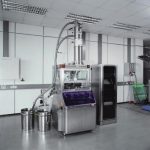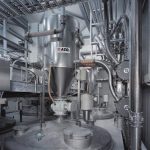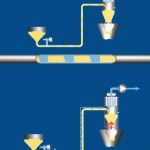Powdery, moist or fatty – the diversity of the bulk materials that can be conveyed by pneumatic systems is today as diverse as the available conveying technologies. New, even gentler processes that generate a further reduction in energy consumption regularly appear in the marketplace. It is not always easy to know which process is best suited to which material. This article outlines the latest developments in pneumatic conveying at Azo.
Walter Sonntag
In principle, it can be said that vacuum pneumatic conveying systems make greatest sense if a product needs to be conveyed from several feeding points to one delivery point. Product entry into the system is particularly simple here with no accumulation of dust, because there is no excess pressure. The blower, which is always situated at the end of the system, generates the partial vacuum required to suck the conveyed prod-uct through the pipelines. This effectively prevents heating of the conveying air.
Pressure conveying systems are best employed if the product has to be conveyed over long distances from one feeding point to several delivery points. Since the prod-uct is conveyed against air pressure, locks or pressure vessels are essential. Product delivery is much simpler, however. In this case, the blower is always installed at the beginning of the system, where it generates the pressure required to blow the conveyed product through the pipelines. If sensitive bulk materials are conveyed, the conveying air has to be partially cooled.
A combination of suction and pressure conveying systems is ideal whenever the product must be conveyed from several feeding points to several delivery points.
The wide range of bulk materials and production processes calls for different kinds of conveying (characteristics). There are basically four different types: dilute-phase conveying, low-velocity conveying, semi-dense phase conveying and dense-phase conveying as well as various mixed configurations.
Simple feeding systems
Simple feeding systems are the classic method of pneumatic conveying for feeding filling and packaging machines, injection moulding machines, dryers, mills and other processing equipment as well as containers, tanks and silos. Bulk materials can be fed from virtually any kind of packaging such as sacks, barrels, containers, silos, etc. From the bulk material feeding point, a partial vacuum causes the product to be sucked via a conveying pipe into a receiver, where it is then separated. After each conveying interval, the filter is automatically cleaned by means of compressed air pulses. All systems are ready for connection, fitted with the latest electronic control systems and capable of providing a signal when there is no longer sufficient bulk material at the feeding point.
If product has to be conveyed to several processing machines at low-to-medium rates, centralised feeding with only one common partial vacuum generator is recommended. All receivers are connected to this generator on the clean air side. The electronic control system scans their respective demand one at a time and switches the appropriate receiver to suction mode by means of an angle valve. As soon as the ‘full’ signalling device in the receiver responds, the conveyor stops and the receiver is emptied. If the receiver is only fitted with a primary filter or very fine dust is involved, a secondary filter can be employed upstream of the partial vacuum generator.
Vacuum pneumatic dense-phase conveying systems
Vacuum pneumatic dense-phase conveying is the most gentle method of pneumatic conveying. It is especially suitable for batch or continuous feeding of processing machines with moist or fatty bulk materials that tend to stick together (e.g. milk powder or cocoa), finished mixtures or sensitive grain structures (e.g. cosmetic mixtures, baking mixtures or instant powders), as well as for conveying very fine or light products such as carbon black or aerosil.
At the product feeding point (sack, barrel, container or silo) the conveyed product is sucked by means of timed air impulses through the conveyor pipe and into the receiver, in which product plugs alternate with air cushions. In the receiver, the conveyed product is gently separated by the conveying air and emptied into the downstream processing machine. The filter cleans itself automatically. A separate level indicator on the machine hopper functions as a demand signaller.
A new trend is now in evidence. In addition to dense-phase conveying, a self-optimising function enables secondary air to be forced into the pneumatic partial vacuum system on demand by means of activators. It is therefore possible to lower the conveying velocity while simultaneously increasing the throughput. This is commonly predicted to be the technology of the future, and in the meantime it has been proved in various systems where bulk materials need to be moved gently and economically over long distances and at a high speed.
Traditional pressure conveying systems
Any powdery or granular bulk materials such as flour, semolina, sugar, salt, PVC powder or pellets are typical examples of conveyed products. The bulk material is fed by means of a rotary feeder (drop-through valve with pick-up pan or blow-through valve). It is important to ensure adequate valve venting. The pressure required for conveying is generated by a blower station. The bulk material is conveyed continuously and distributed to the respective separators, tanks or silos via pipe gates. Suitably dimensioned filters must be provided at the product delivery points.
Pressure dense-phase conveying
The products typically handled by these conveyors include all granular or powdery bulk materials that cannot be conveyed via locks because too much ab- rasion would occur. This is the case with highly abrasive products like cement, salt or minerals and is most relevant at very high conveying rates.
The pressure vessel is filled from above, for example from a scale, tank, silo or sack feeding station. The pressure vessel is then sealed pressure-tight and the required conveying pressure is applied. This pres-sure can be generated by a rotary piston blower or taken from the compressed air network. The distribution of compressed air to the product and bypass is controlled and monitored according to the pressure by an electronic, self-optimising control unit. Only when an empty state is signalled can a new filling cycle be started. In many cases, emptying is monitored according to weight.
Dense-phase conveying also takes place here, i.e. an air cushion is forced into the conveying pipe between each product plug by means of a special conveying-air feed device (Laval nozzle). The product is distributed via pipe gates to separators that are designed for pressure conveying systems and equipped with correspondingly large filters.
Once again, a new trend is in evidence. Secondary air is introduced into the conveying pipe via activators according to a pressure-dependent control principle, to allow bulk materials to be transported especially gently and eco-nomically at very low conveying velocities and over very long distances.
The future of pneumatic conveying systems
An exciting future lies ahead for pneumatic conveying systems. New product feeding technologies are regularly developed, for example suction nozzles, suction hoppers, rotary valves and vibrating dosing screws. The same applies to the receivers where the product is collected. In the meantime, receivers are available with a pendulum flap, a conical valve, a butterfly valve or a rotary valve for continuous operation. Ring blowers, vacuum pumps (especially Mink pumps) and rotary piston blowers are used in vacuum pneumatic conveying systems to generate partial vacuum. In pressure conveying systems, the required pressure is generated by ring blowers, rotary piston blowers and helical piston compressors. New production technologies enable drop-through valves, blow-through valves and high-pressure airlocks to be manufactured more and more precisely with the aim of reducing air leakage. The vessels in modern pressure-vessel conveying systems are smaller than ever because filling and discharging can be designed much more easily with the help of intelligent control technologies. On the product feeding side, receivers with a butterfly valve, a rotary airlock or – in case of direct silo filling – corresponding pipe bottoms and dust filters remain the optimum solution. New materials permit abrasive products to be conveyed reliably over a long period of time, while innovative filter materials allow continuous pneumatic conveying of very fine dusts without any reduction in filter capacity. All in all, there is a lot to look forward to.
Hall 6.0, Booth E18
cpp 400
Directly to AZO
Achema 2006
Share:









